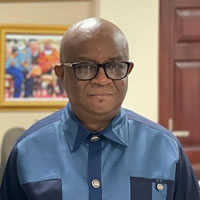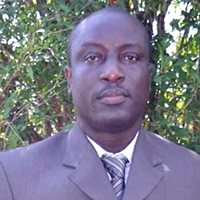There are eight major ethnic groups in the region speaking different languages. There are also an estimated 62 sub-groups speaking 56 dialects. The major ethnic group is the Ewe, followed by the Guan, the Akan and Gurma. The Guan comprises over 18 sub-groups and the Akan over 19 sub-groups. The less prominent ethnic groups include the Ga-Dangme, Mole-Dagbon, Grusi, and the Mande-Busanga.
Traditional Structure
The people of the Volta Region are organized under chiefs at the lineage and settlement levels. A lineage comprises extended families that trace their genealogy to the same ancestor. The extended families also have heads who are most often the oldest male. With the exception of Kadjebi District and a few areas in Jasikan District, ownership of property is passed on by patrilineal inheritance in all the other districts.
The Volta Regional House of Chiefs, like similar institutions in the other regions, was established by statute in 1958. The Legislative Instrument 991 of 1974 defined the composition of the Volta Regional House of Chiefs to consist of 15 paramount chiefs (in charge of 15 Traditional Councils) and 17 rotating members (from 17 groupings) bringing the total membership to 32.
The Traditional Council is composed of several area councils. The traditional authorities administer stool lands, holding them in trust for the people, and arrange the celebration of traditional festivals. They are also the custodians of traditional beliefs and customs, passed on from one generation to another. The traditional authorities also have courts which adjudicate on matters relating to stool lands, lineage and family lands, chieftaincy disputes, violations of traditions and disputes between localities, lineages, families and individuals. In the Volta Region, no paramountcy owes allegiance to another paramountcy.
Tourism
The Volta Region has untapped tourism potential capable of transforming the region’s economy and its overall contribution to national income when fully developed. The beautiful landscape, clean environment of the towns, numerous eco-tourism sites and the rich cultural heritage epitomized by kente weaving, make it one of the most important tourism areas in the country. Some of the tourist sites in the region include Amedzofe Mountain, Tagbo Falls near Hohoe, TafiAtome Monkey Sanctuary and Xavi Bird Watching Sanctuary. Other areas marked for tourism development include the Wli Waterfalls in the Hohoe District, the Kpetoe Kente Village, Adaklu Mountain eco-tourism sites both in the Adaklu-Anyigbe District, Shari Hilltop Unique Village in the Nkwanta District and Bowiri Lacham Village in the Jasikan District.
Ethnicity
The Volta Region has residents from just about every ethnic group in Ghana. Based on classifications by the Bureau of Ghana Languages, there are eight major ethnic groups in the region and about 62 sub-groups, speaking 56 different dialects. The main ethnic group is the Ewe (73.8%), followed by Gurma (11.3%) and the Guan (8.1%). Each of the other ethnic groups has less than 3 percent of the population. Across the district the distribution of the major ethnic group, the Ewe, follows two patterns.
The first pattern consists of 11 districts where the overwhelming majority of the population is Ewe. These districts are South Tongu, Keta, Ketu South, Ketu North, Akatsi, North Tongu, AdakluAnyigbe, Ho, South Dayi, North Dayi and Hohoe. The second pattern is made up districts where the Ewe group is in the minority. The districts are Biakoye, Jasikan, Kadjebi, Krachi East, Krachi West, Nkwanta South, and Nkwanta North.
Religious Affiliation
The people of the region originally practiced traditional religion. However, with the arrival of Christian missionaries in the 19th century, many people converted to Christianity. While the Ewe, Guan, and the Akan are mostly Christian, a substantial number of the other ethnic groups such as the Hausa, Kokomba, Nanumba and Gurma are Muslim. Majority of the population are Christians, 14.1 practice traditional religion and 5.7 percent are Muslims.
Among the Christians just a little over one in five are either Protestants or Pentecostal/Charismatic Most of the people practicing the Islamic religion are found in Kadjebi, Krachi West, Nkwanta South and Nkwanta North, while four districts have substantial proportions of their population practicing traditional religion: Nkwanta North (43.3%), Ketu North (33.5%), Ketu South (27.9%) and Akatsi (27.9%).
Marital Status by Age
Early marriage is prevalent in populations where marriage is universal. Early marriage and early child birth are known to be implicated in poor pregnancy outcomes for the mother and child and are also likely to result in dissolution due to the inexperience of the couple. The data reveal that across all ages, 49.2 percent of the population 12 years and older is in some form of union, consisting of 46.6 percent who are married and 4.6 percent who are in consensual union.
In addition, 13 percent have once been married but are now divorced, separated, or widowed. As expected, higher proportions of the widowed are in the older age groups, 60-64, 65-69 and 70 and over (21.1%, 27.1% and 45.8% respectively). The rate of divorce also increases with increasing age: persons over 50 years, but excluding those 70 years and over, are more likely to divorce than persons in the younger age groups.
Marital Status by Sex
In many traditional societies in Ghana, males are more likely to delay marriage than females. However, more widespread education has extended the age at marriage for females. Table 5.2 shows the percentage distribution of marital status by sex. It is observed that a higher proportion of females are married (46.5%) than their male counterparts (42.5%). There are also substantially more females who are widowed (11.0%), divorced (4.1%) and separated (3.3%) than males (2.0%, 2.7% and 2.2% respectively).
Marital Status by Locality of Residence
Persons living in rural areas are more likely to be married (45.9%) than persons in urban areas (42.3%). The proportion never married is in turn higher in urban areas than rural areas. It is noteworthy that there are little variations in proportions in consensual unions, separated and divorced between the localities of residence. However, female widowhood is more prevalent in rural areas (7.2%) than in urban areas (5.9%).
Marital Status by Education
In general, education delays marriage for both men and women. Because of the likely role conflict between education and raising a family, people now postpone marriage until they have completed their education. People with post-graduate education have the highest proportion of married people (76.0%), followed by those who have completed middle school (65.9%), and those with vocational/technical/commercial education (62.7%).
It is also noted that about three out of ten of people who have attained only primary or junior high school education are married and over one half of those who have never been to school are also married. The proportion of individuals who have never married ranges from a low of 15.1 percent of those who have never been to school to a high of 67.6 percent of those who have secondary school education.
Separation and divorce are more common among people with middle school education than those in the other educational attainment categories, while widowhood is common among those with no education.
Marital Status by Religion
Most religions lay strong emphasis on procreation within marriage. There is, therefore, the need to examine people?s marital status by their religious affiliation. The proportion married is above 40 percent across all the religious groups. Substantial proportions of the never married are also found in all the religious categories. Interestingly, divorce and separation, which are not approved in most religions, is lowest among Muslims compared to the other religious groups. People who profess traditional religion have the highest proportion of the widowed (11.5%), followed by those with no religion (8.0%) and those who adhere to the Protestant religion (7.1%).
Marital Status and Economic Activity
As expected, about six out of ten people married are employed compared to three out of ten for the unemployed and one out of five for the not economically active, which includes students and retirees. Similarly, 67.1 percent of the not economically active have never been married against 20.6 percent for the employed. The table further shows that the proportion of persons in informal/consensual unions is higher in the unemployed category (7.6%) than the employed category (5.8%). The proportion widowed is largest for the not economically active (8.6%), followed by the employed (5.9%), while the unemployed has the lowest proportion of the widowed (2.8%).
Date Created : 12/14/2017 3:56:31 AM




